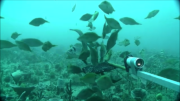fish
Type of resources
Topics
Keywords
Contact for the resource
Provided by
Years
-

This record provides an overview of the scope and research output of NESP Marine Biodiversity Hub Project A10 - "Conservation of handfish and their habitat". For specific data outputs from this project, please see child records associated with this metadata. -------------------- Spotted and red handfish are critically endangered. Prior to 2019, this project commenced a scientifically robust monitoring program to track conservation trajectories and performance of recovery plan actions across all known sub-populations of Spotted Handfish. An innovative geo-reference photographic method provided both capture-mark-recapture information and sub-population fish densities as a proxy for abundance. Collecting this data was a crucial first step for a future project of targeted placement of artificial spawning habitat (ASH) and to determine minimum population size to inform sustainable capture of brood-stock for captive breeding. From 2019-2020, the project was extended to include Red Handfish. In accordance with the signed Handfish Recovery Plan, this project will conserve Red and Spotted Handfish through various direct conservation actions guided by research. This includes replanting of the degraded plastic artificial spawning habitats (ASH) with a re-designed array of ceramic units, assessment of taut eco-friendly moorings in critical spotted handfish habitat, genetic and capture mark recapture studies for both species, a population viability analysis (PVA) and performance assessment of management actions. The project will also continue a captive breeding project with industry, and engage with the broader community through talks, outreach and publications and re-establishment of the handfish recovery team.
-

The Flinders CMR survey was a pilot study undertaken in August 2012 as part of the National Marine Biodiversity Hub's National monitoring, evaluation and reporting theme. The aim of this theme is to develop a bluepint for the sustained monitoring of the South-east Commonwealth Marine Reserve Network. The particular aims of the survey were twofold; 1) to contribute to an inventory of demersal and epibenthic conservation values in the reserve and 2) to test methodologies and deployment strategies in order to inform future survey design efforts. Several gear types were deployed; including multibeam sonar, shallow-water (less than 150m) Baited Remote Underwater Video (BRUVs), deep- water BRUVs, towed video and digital stereo stills. This resource contains the shallow-water BRUV footage captured on the FLinders CMR shelf (less than 150 m). Stereo BRUV's were deployed using a probabalistic and spatially-balanced survey design called Generalized Random Tessellation Stratified (GRTS). Habitats were identified in a previous multibeam survey and consisted of 'mixed reef' (containing patchy reef) and sand. Mixed reef habitat was targeted in this survey (9 GRTS mixed reef sites versus 3 sand sites). A total of 60 stereo BRUVs were deployed. Data contained here represents footage collected using these drops and the associated scored data (abundance (MaxN) and lengths).
 IMAS Metadata Catalogue
IMAS Metadata Catalogue